Growing & Marketing
By Nikki Thapa, Nepal
A mere thirty-three miles from Mount Everest in the world’s deepest valley—Khandbari in Nepal—grow some of the finest rudraksha trees on earth, selected and cultivated over the centuries by tree farmers who have become a significant part of Nepal’s export commodities. The dried beads (each containing one or more seeds) of the rudraksha fruit have long been sacred to Hindus. Associated with God Siva, they are used as prayer beads and commonly worn for protection. According to legend, as He looked down on earth and witnessed all the suffering that humans had created, Siva shed a tear. The tear fell to earth and from it grew the first rudraksha tree. Over time rudraksha trees proliferated, granting a host of new opportunities and challenges to Nepal’s farmers and traders. Indeed, in not so many decades, the rudraksha bead has caused a significant economic stir.
While previously Nepalese traders were the rudraksha farmers’ primary buyers for the Indian market, the trade has grown more complex. Some farmers have also become traders, while many buyers are contracting with farmers for the yield of trees far before the beads have even been harvested.
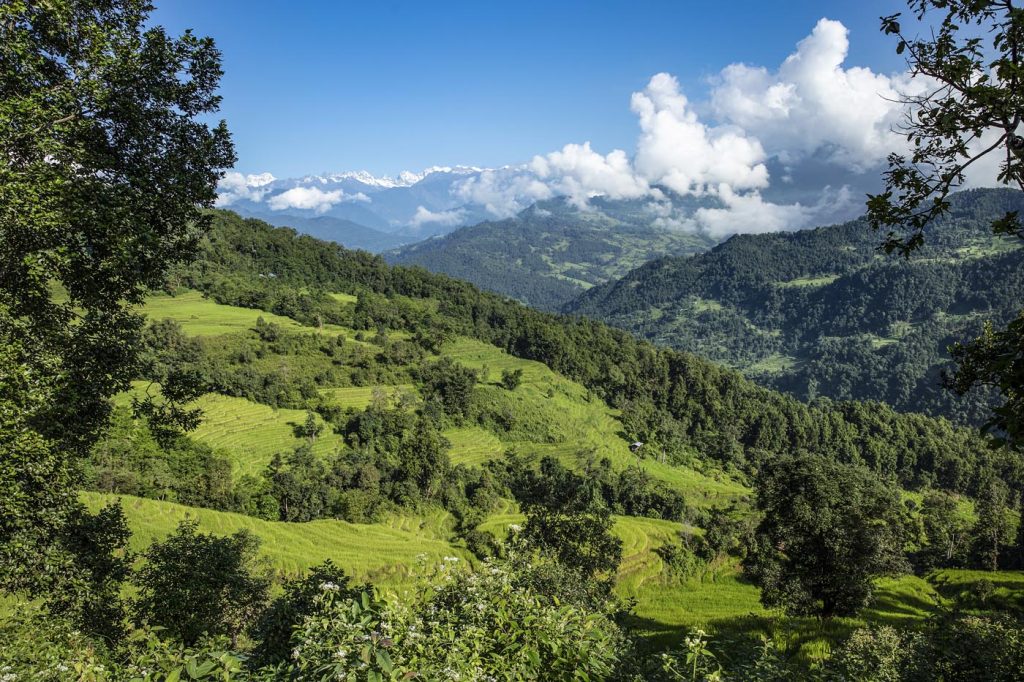

In a dynamic shift, Chinese merchants have entered the trade, traveling to Nepal to buy from farmers and traders in local bazaars, or to contract directly with forest farms. The Chinese trade began about ten years ago, when rudraksha malas and bracelets became fashionable in China. As a result, rudraksha jumped in value, as Chinese buyers were willing to pay higher rates. Before the pandemic, an estimated 500 Chinese businessmen arrived on tourist visas just to buy beads. The recorded income from their purchases was close to $650,000 for 980,444 pounds of beads. During 2020-21, rudrakshas were Nepal’s tenth most valuable export commodity to China, although Nepal recorded selling only 619,221 pounds, worth about $200,000. Because this is an informal cash business, actual annual export figures are higher than those recorded and are probably in the billions of rupees.


As soon as the monsoon season ends, Nepalese farmers and traders converge in Khandbari, a valley in eastern Sankhuwasabha district. They arrive anxious and eager as the bidding begins for their loads of mukhdaars—beads with eight or more mukha or “faces” (segments)—for which there is no fixed price. The traders count the number of mukhas, roll the beads in their hands and tap them against their teeth to ascertain their weight and compactness. Mukhdaars are prized by the Indian buyers, the long-established market that values these many-faceted beads for their religious significance.
Although most traders a well known among themselves, other local people join in the action. Schoolboys arrive and negotiate hard, smiling proudly as they wave a hefty bundle of elephants (slang for Nepalese 1,000-rupee notes, on which an elephant is pictured). An elderly woman wanders into the bazaar with a beautiful nine-mukha bead she has just plucked from a tree by her house. I keep my eye on her as the traders descend, fearful she may be duped into selling it cheaply. Soon I am relieved as she pockets a good sum of money.
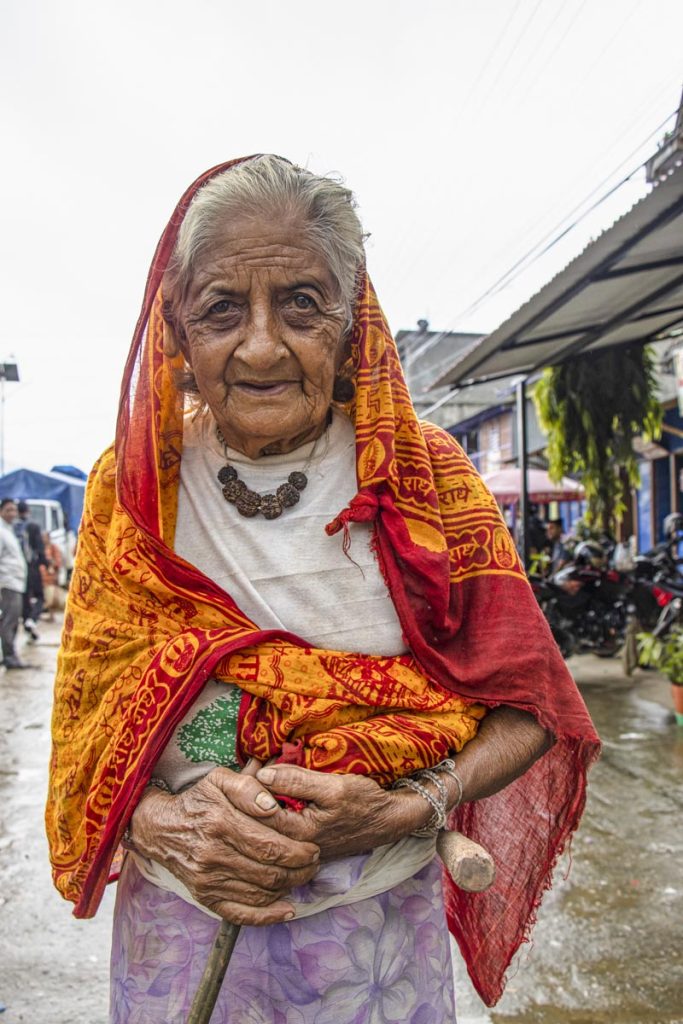

With the arrival of Chinese traders in late autumn, trading intensifies, with larger sums of money exchanged. The sacred bead has brought forth an international event. Shang Fuheng and his Korean girlfriend Park su Zee are bargaining with a Nepalese farmer over a single bead. It’s their fifth year in the business and the Nepali translator that they hired through a travel agency tells me they have been selling their beads on WeChat and TikTok. Shang Fuheng holds the bead in his palm, measures it with his calipers, and examines its mukhi. He turns the bead round and round while the farmer waits in suspense. I wonder if the bead’s odd shape was created by the farmer putting it in a clamp while the fruit still hung on the tree. Bulging at the center and relatively flat on top and bottom, the shape of such beads appeals to the Chinese market, whereas Indian customers eschew such manipulated beads.
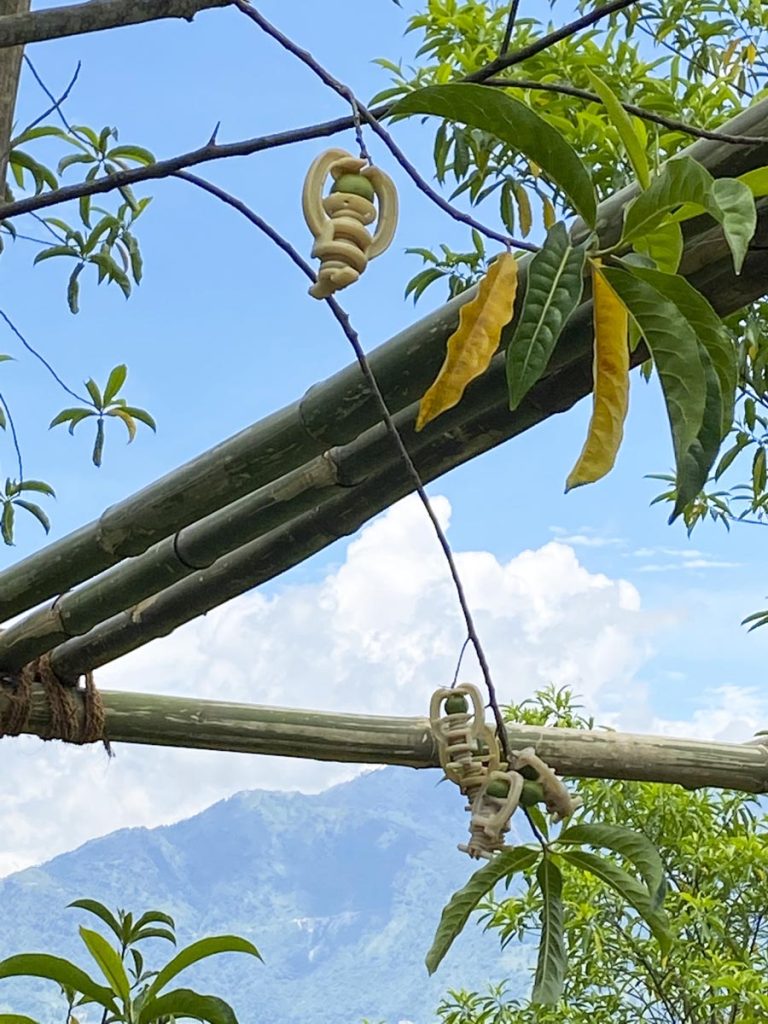

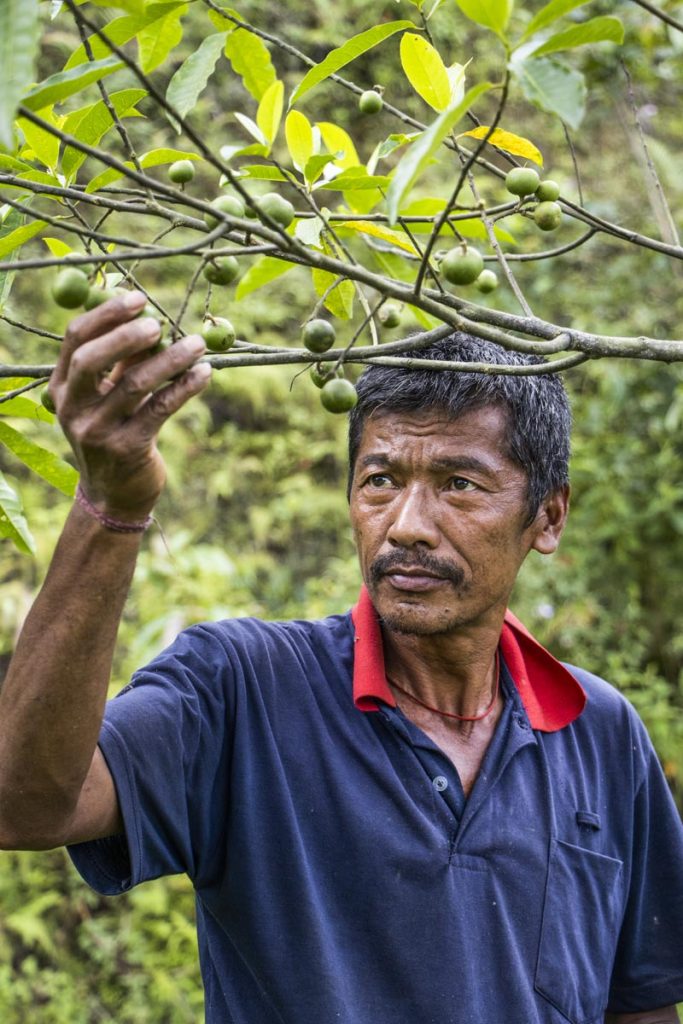

Many Chinese traders wire their yuan to a Chinese entrepreneur in Jyatha, Kathmandu’s de facto China Town. The entrepreneur then transfers rupees in installments to rural Khandbari so that they have plenty of cash on hand for trading in the weeks ahead.
Through his translator, Shang Fuheng names the price, and the farmer protests several times until an agreement is reached. Shang Fuheng counts out rupee notes from his leather pouch, makes the payment. Quickly he and the farmer part company to search for new transactions.
“I’m aware that Hindus hold these beads in high respect,” Liu Sulin, another Chinese trader, tells me, “but the whole reason I’m in this business is to make money.” Liu, who has been trading for fifteen years, laughs when I ask if he’s become rich. “I recently bought a Mercedes,” he admits, “but I don’t own a house.” He predicts that the already declining rudraksha trend in China will phase out within six years, while trade to India will remain steady.
“Wearing a rudraksha bracelet is a fashion in my country,” he comments matter-of-factly. “Like any other trend, it will have a short life span.”
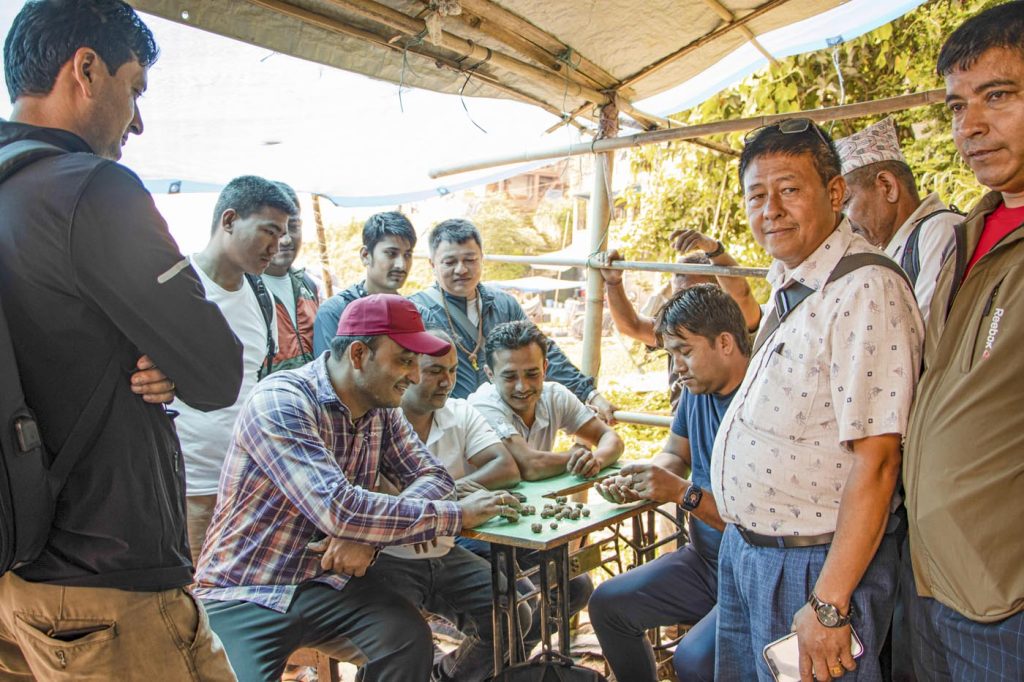

In the evening, I meet Chinese traders gathered at the Kanchenjunga Hotel in Tumlingtar and would later meet up with Prakash Giri who would help us get to know them. Each year Prakash rents a room here for three months to conduct his trade. Once serving as a Chinese translator for $80 a day, he decided to join the rudraksha business himself. “Within seven years I bought a house and two more plots in Kathmandu. Why shouldn’t I be in the business if I can earn ten lakhs ($7,500) from a one-lakh investment?”
Sambhu Shrestha, a trader from the local community, takes another view. To Sambhu, even someone like Prakash is a bigshot trader, like others who have bought houses in Kathmandu and whose children go to expensive medical or engineering schools. “It is not easy to get good beads without hard bargaining and competing with other buyers,” he says. Sambhu walks for days in and around the neighboring villages, in sun and rain, to collect the season’s finest beads.
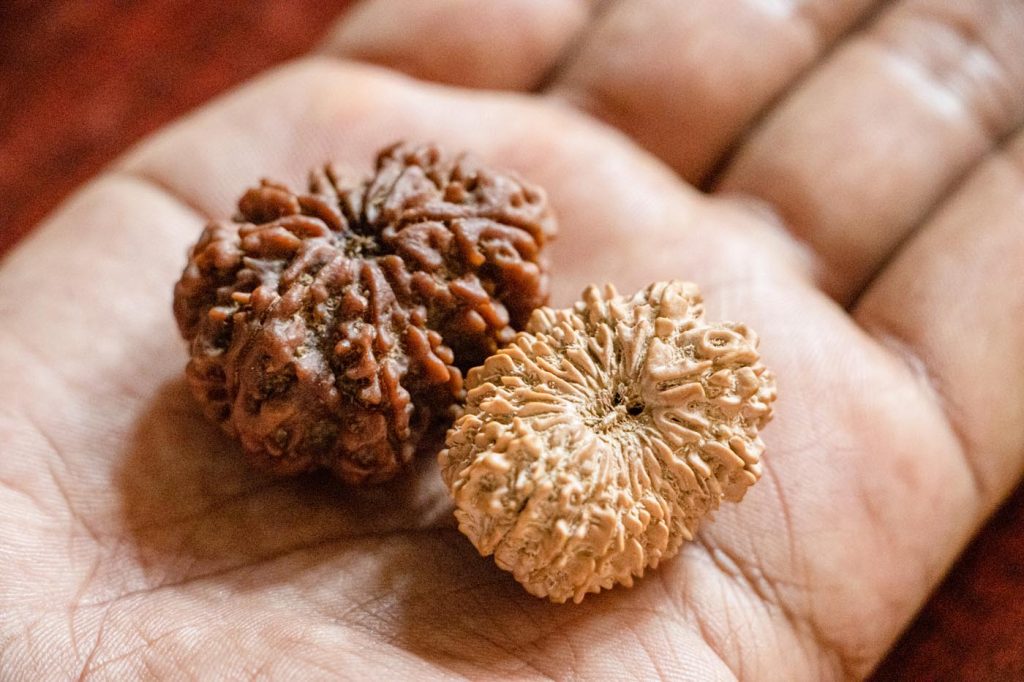

“I sell the beads to bigger businessmen in Kathmandu,” he continues. “These guys try to take advantage of the fact that most of us have had to take out loans to do this business. So, I often end up selling with little profit margin or even at cost so that I don’t have to pay the interest on my loans.”
Few of the world’s fruit stones have received such careful attention to their peculiarities, or been categorized and ranked according to their value and special features. Rudrakshas with one, two and twenty-one facets (mukhi) are considered rare and hence most valuable. Four, five, six and seven mukhi beads are ordinary. Many Chinese buyers are often satisfied to buy up the ordinary ones, while Indians have cultivated a preference for mukhdaars (beads with eight or more mukhas) or beads that are larger in size, are “prickly,” or bear several facets with clear, deep mukhas. One tree can produce different sizes of beads, with up to 23 different mukha (or mukhi). Other unique beads are the Gauri Shankar (two beads naturally conjoined) and Trijuti (three beads naturally conjoined.)
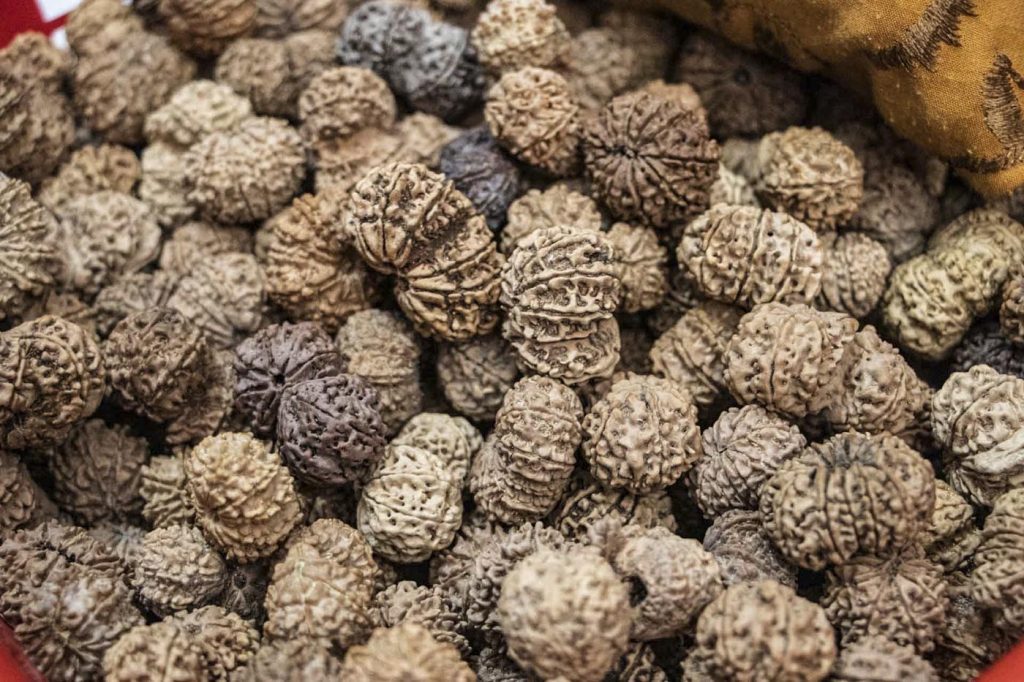

Some claim that certain trees give low numbers of faces and others yield the highly prized high-numbered beads. This is a misconception. While trees of different cultivars do give reliable sizes, small to large, the many-faced beads come as genetic anomalies from all trees. While real numbers have never been established, one might find a ten-faced bead among 20,000 harvested and a single-faced bead in a million. It takes a patient eye and hours or days of sifting through the harvest to find the truly precious ones.
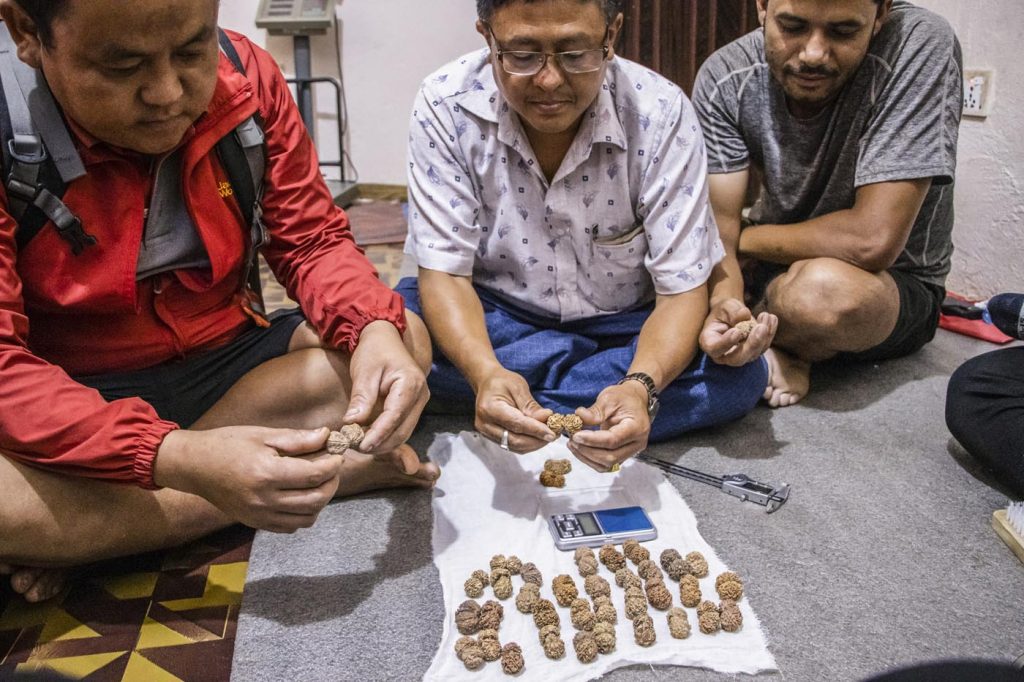

According to Hindu astrology, each mukha corresponds to a particular Deity and planet, and provides specific benefits. One astrologer advises that thirteen mukhi helps to make timely actions in making deals, whereas twenty-one mukhi will attract wealth. Most wearers believe that rudraksha beads are bestowed with special powers by Lord Siva, protecting wearers and helping them overcome obstacles on their spiritual journey. The Padma Purana states that rudraksha beads are not objects of worship in themselves but can be used as aids in the spiritual quest. Because the beads contain numerous beneficial compounds, it is believed that wearing them helps to control stress, regulate blood pressure, improve concentration, treat rheumatism and regulate heartbeat. Other benefits are also claimed, ranging from elimination of diabetes to curing of mental disorders. A Buddhist healer explained that he breaks open the fresh bead, removes the viable seeds and crushes them together with certain herbs to create a medicine that strengthens the cardiac muscle. It is his go-to prescription for patients with heart problems.
I once purchased a Gauri Shankar bead. The larger of these conjoined beads is referred to as almighty Siva, whereas the smaller one is Goddess Parvati: their joining represents their celestial union. I bought the Gauri Shankar on the advice of my astrologer who said it would brighten my future, but it turned out to be a fake. Two beads had been glued together! Later, my jeweler was able to source for me a genuine bead from a distant relative.
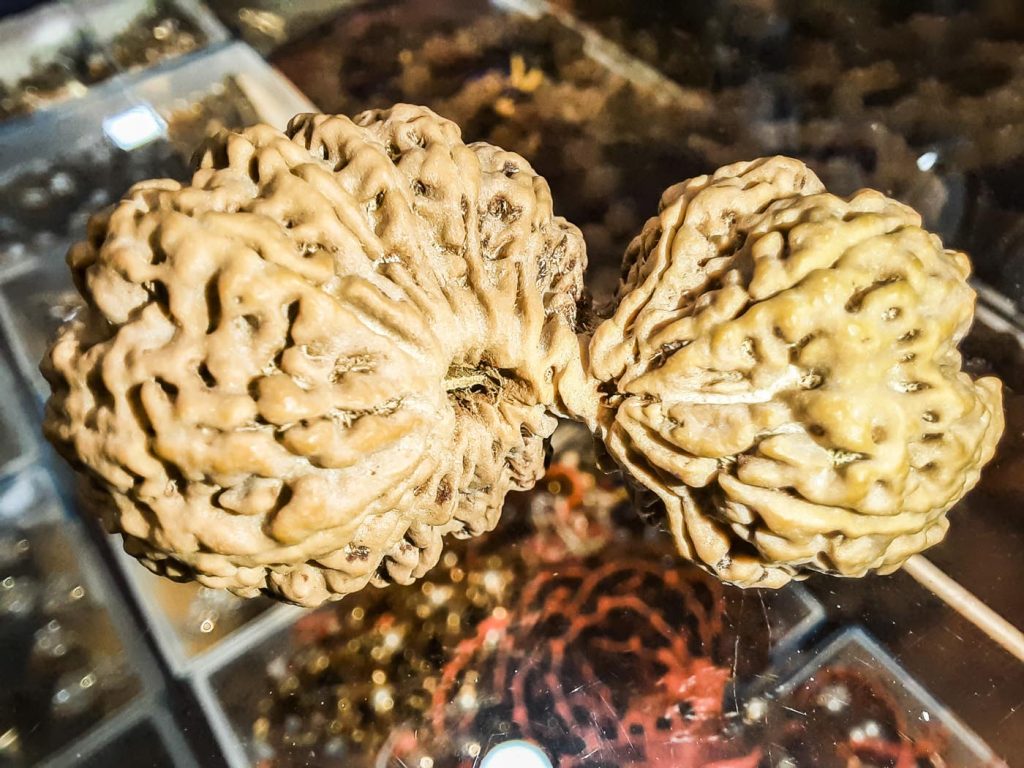

So when I return to the Khandbari bazaar the following week, I am intrigued to see buyers, one Chinese and one Nepalese, competing to buy a Gauri Shankar from a farmer. It is as if the power play between China and India is represented in this three way barter. In this instance the Chinese buyer wins, the Nepalese trader walks off frustrated, and the farmer looks pleased. I am left wondering—was the Gauri Shankar genuine?
“My eyes are well trained, and I can tell in a heartbeat if the beads are real or fake,” Nagesh Basnet tells me proudly. He only buys mukhdaars, claiming that 80% of all mukhdaars pass through his home in Kathmandu. “Nonetheless, I have to certify each before pitching it to high-end boutiques in India.”
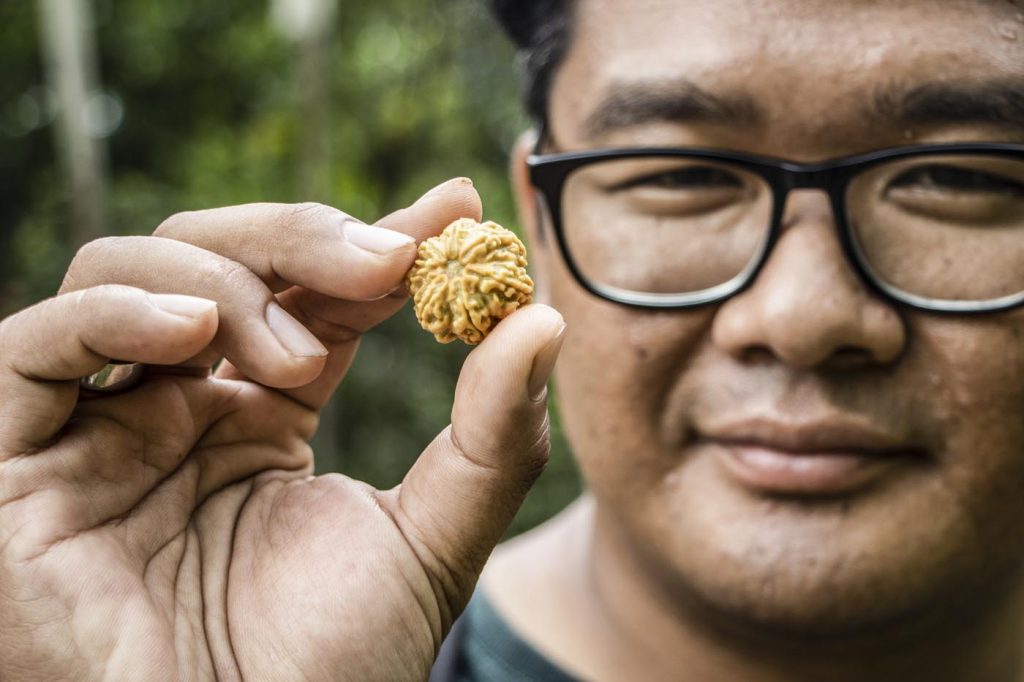

According to Nagesh, it was his father who started the first commercial rudraksha plantation. Before that, the trees were viewed primarily as good firewood, while people ate the not-so-appetizing ripened skin and pulp. Sometimes the beads were given as alms to sadhus, with the best ones brought as offerings to Pashupatinath or Varanasi, but their commercial value had not yet been considered, nor had the opportunity for deceit.
“I am planning to buy a scanning machine and set up a government-certified lab in Kathmandu,” Nagesh tells me. “It would make sense if Nepal, the country of origin, were to issue a certificate of authenticity for rudrakshas.”
I hear his concerns echoed by Kabir Singh, an Indian buyer who spends almost two months in the region sourcing beads. He is not in a happy mood when I encounter him, carrying his purchases of the day. “As a customer, I expected good service but I am not getting any. There is no testing lab in Nepal. I have to scan all my purchases on my return to India and, in case of fakes, I have to courier them back to exchange them. The only thing they do here to test the rudraksha is tap them against their teeth! They put something so spiritual in their mouths! And the bacteria passing from one person to another, especially during the COVID pandemic!” Kabir rolls his eyes in despair.
At the hotel after another day of negotiations, Chinese traders watch TikTok as their interpreters swap stories with Nepalese traders. Kabir Singh has his day’s purchases on a table, measuring and discussing them with other traders. I reflect on my own impressions: farmers carrying mukhdaars and bundles of money in worn backpacks, and Chinese traders receiving impromptu wire transfers equivalent to thousands of dollars to buy only 10 kilograms of beads. A single twenty-one mukhdaar sold for the cost of a car. I am astounded how these barters in the small bazaar involve so much money. Despite all of cash exchanged, I muse whether the farmers are earning enough.
Nagesh explains the pattern: a farmer will sell to a local trader, who sells to a regional one, and then finally to an international entrepreneur who exports to Indian Hindus worldwide. “I have heard that Prime Minister Modi, actor Amithabh Bachan and other famous Hindus own these valuables. Many of the special beads originated with me, but there are many people involved before they make it to their posh destinations.”
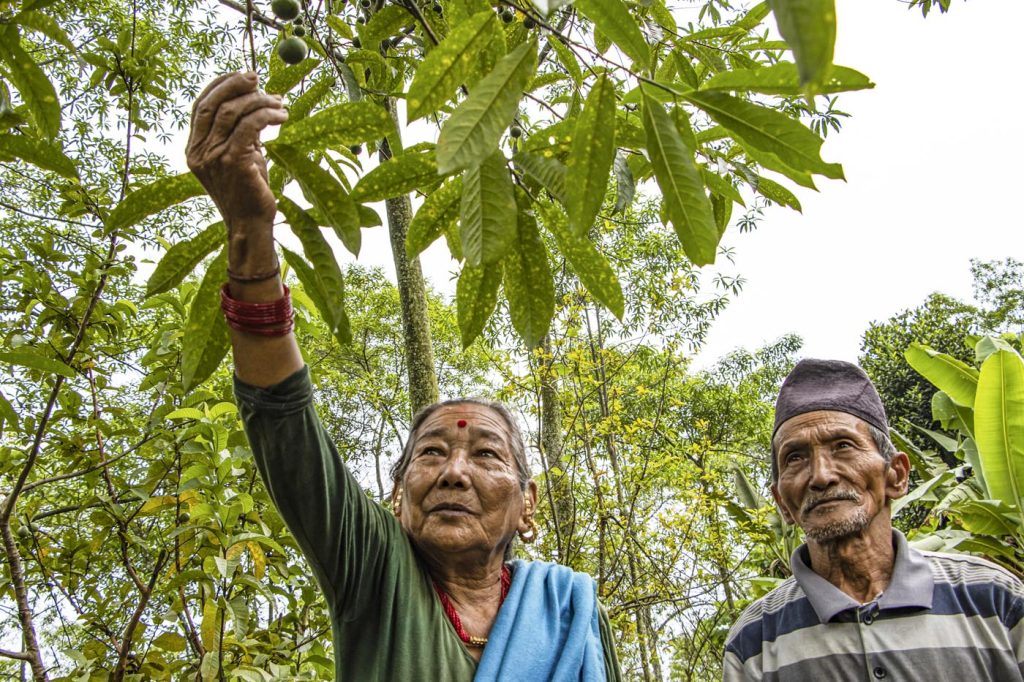

Yet patterns in trade are in flux: one local farmer reports a bonanza upon having sold 1,500 beads from a single tree to a businessman for $7,500. He says that the rudraksha bead that once sold for five rupees now fetches Rs 2,000, thanks to the interest of the Chinese. It seems that through the direct sales to Chinese traders, farmers stand to gain increased benefit—for as long as the trade with China holds.
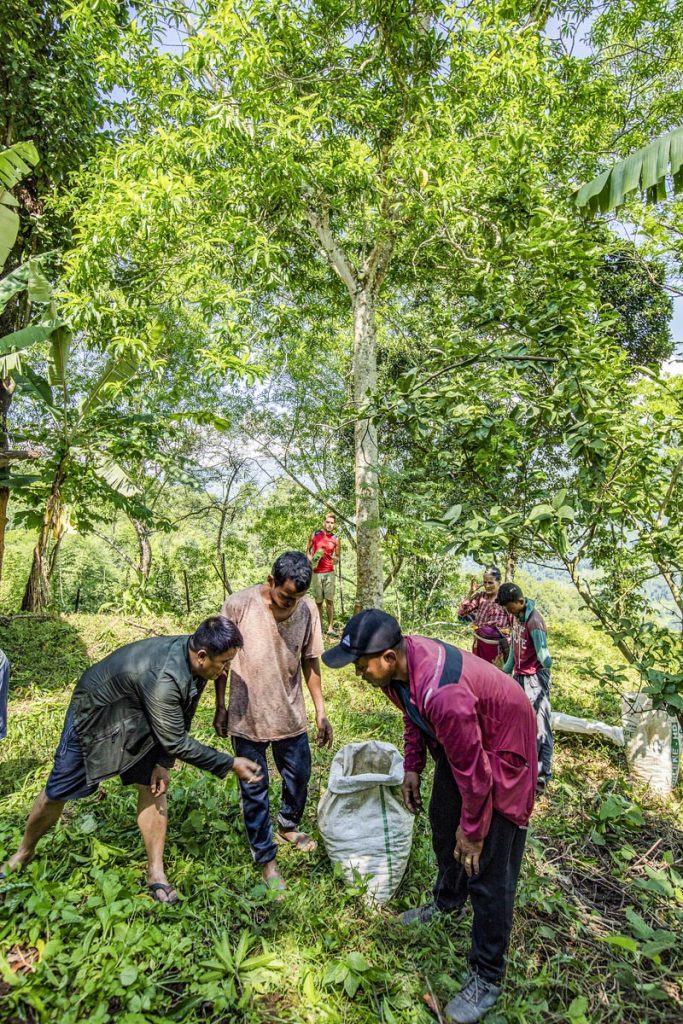

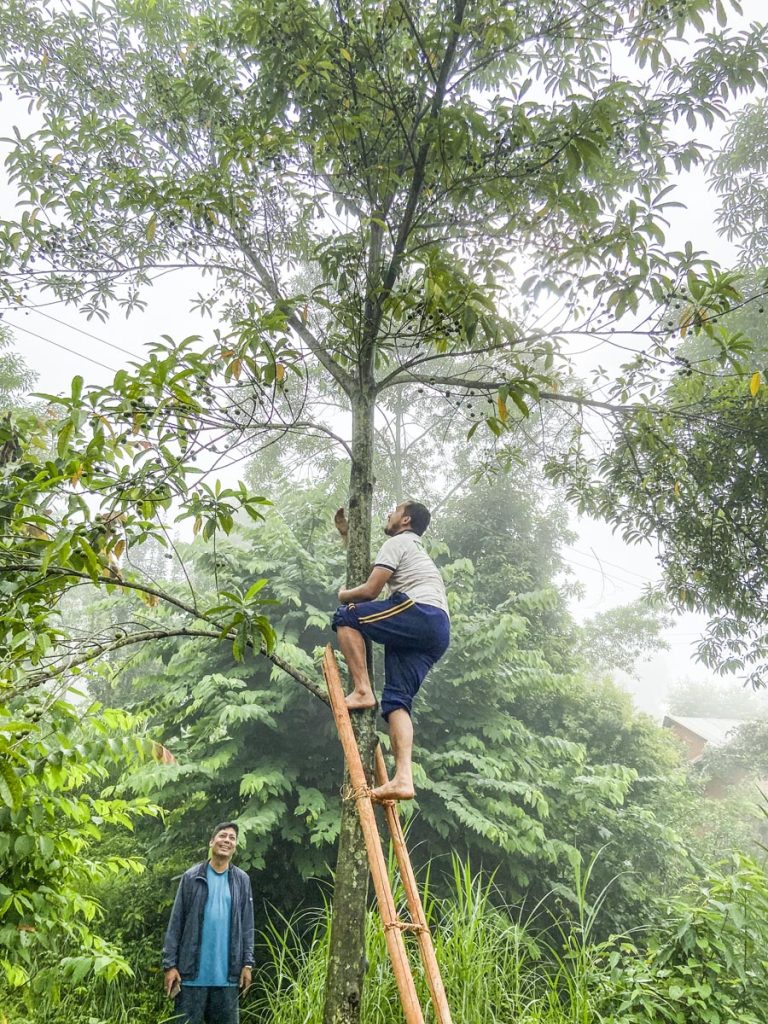

The Farmers
The first time I visited the farms of Bhojpur district as Hinduism Today’s journalist was during the early harvest season, in September of 2022, in the company of trader Agam Singh Rai. That first annual harvest yields mostly mukhdaars, while the second harvest, between the holidays of Dashain and Tihar, yields more common varieties.


I arrive in this lush valley with the notion, I’m in “old Nepal” (out of the trekking zone, though just 33 miles from Everest) and entering deep into Nepal’s eastern rural hills and villages. As we bump along in our jeep through a lush green rudraksha forest, Chinese men on motorcycles overtake us. They are heading to the forest, we are told, to check out the rudraksha trees they have contracted from local farmers. This direct contracting began when Chinese traders in search of beads around Kathmandu’s Pashupathinath Temple crossed paths with the rudraksha farmers. The traders cut out the middlemen and instead spend months contracting for the yield of entire trees, each for a thousand dollars.


Agam Singh Rai, for example, choose trees after inspecting the flowers and young fruit in the spring, making verbal, non-binding contracts with farmers. We meet Govinda and Deepak Kattuwal, who have contracted to Agam Singh Rai the entire year’s yield off their 150 rudraksha trees, which covers five acres. The forests around us are busy with pickers and packers hired by different contractors. The teams have come with tents, sleeping bags and enough food and drink to last the duration of their work.
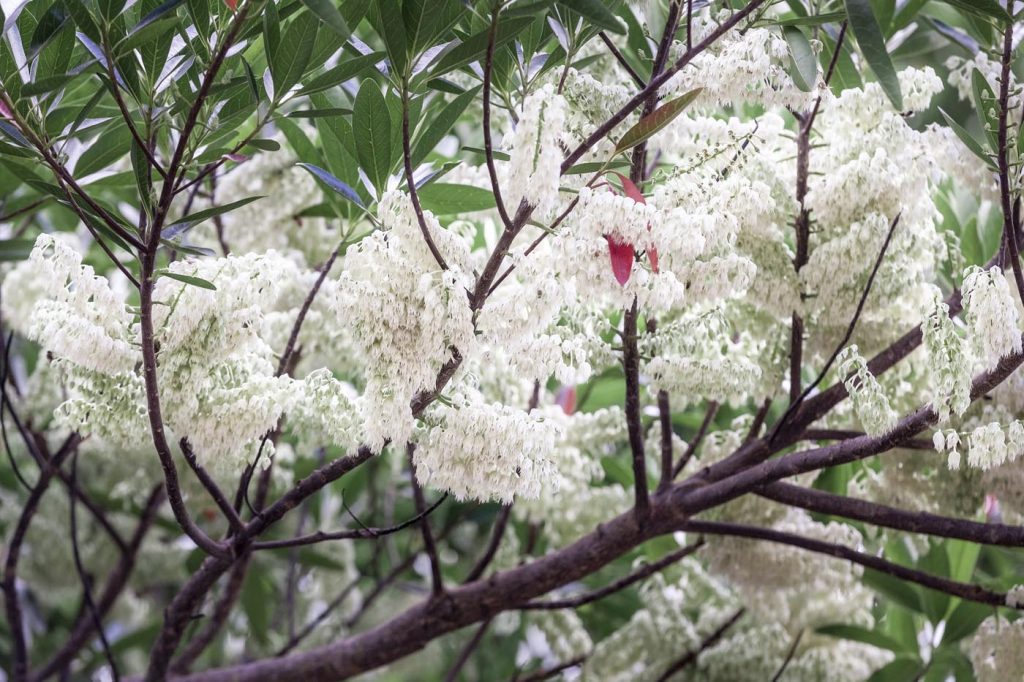

When we park by the Kuttuwals’ forest, agile young men and women are climbing high into the trees to free the fruit from the branches. I watch anxiously as they take off their plastic sandals and scale the tall trees, balancing nimbly on high limbs, partly obscured by foliage. Finding a strong branch, they stop to strike the fruits with a long bamboo pole that has been fitted with a forked end. Where trees are short, they strike with their poles from the ground. Then, during a break, fallen beads are packed into bags. The work must be done in rotation to prevent the pickers from being hit like a bullet by the falling beads.
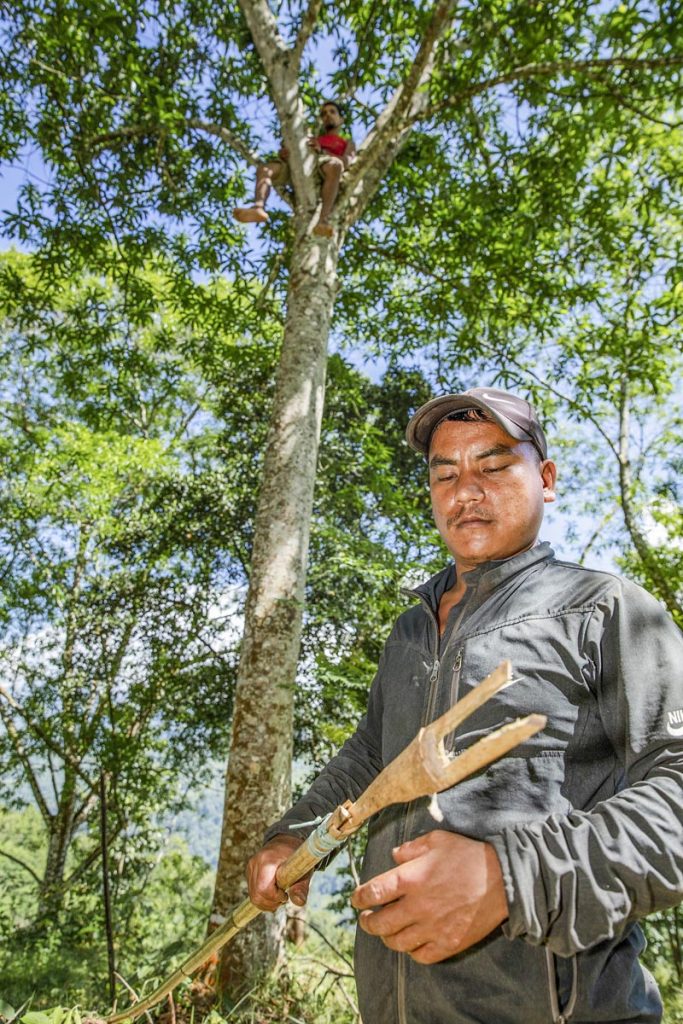

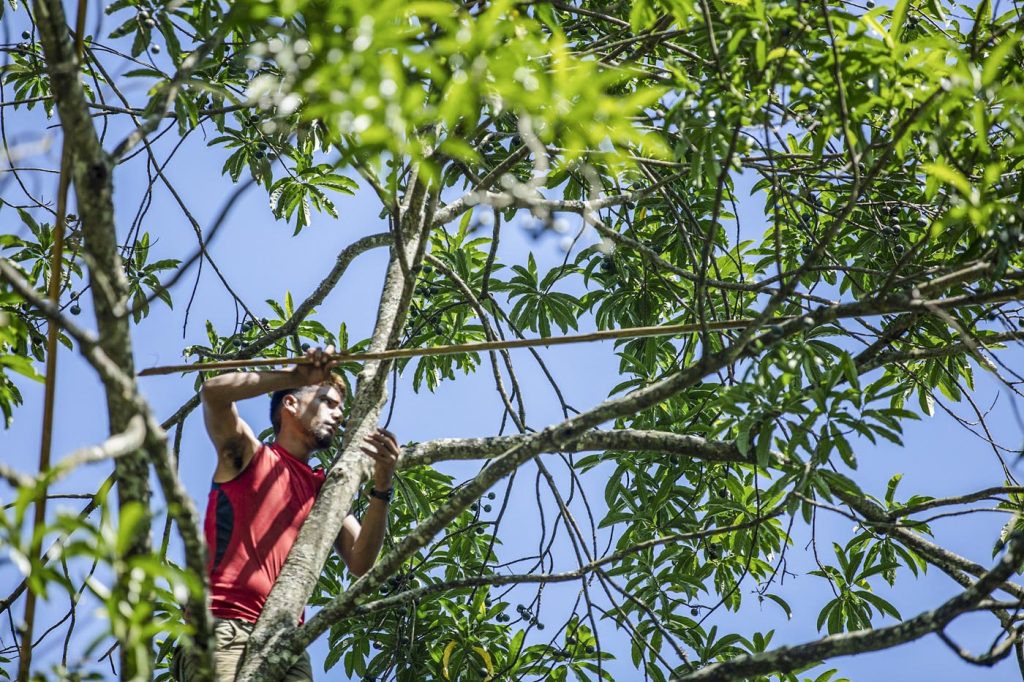

To show me the quality, Deepak Kuttuwal and his friend Anil Rai crack open the blue outer husk with a wooden block or use a machete (khukuri) and then brush the bead with a comb. Traditionally this the way of cleaning the beads, scrubbing them with a brush under running water, then wrapped in fine muslin after drying. Agam Singh Rai laments, “It was fun in the old days when all the farmers set out very early in the morning to the nearby river to wash our harvest. We’d spread the beads on plastic tarps along the river bank to dry in the sun. We had picnics, or played cards while keeping a watchful eye on the beads.” Those days are gone. Today the beads are packed into sacks and stored in a dark room for one week till the outer husk decays. The shriveled beads are then cleaned in bulk with a pressure washer, making the work much faster.
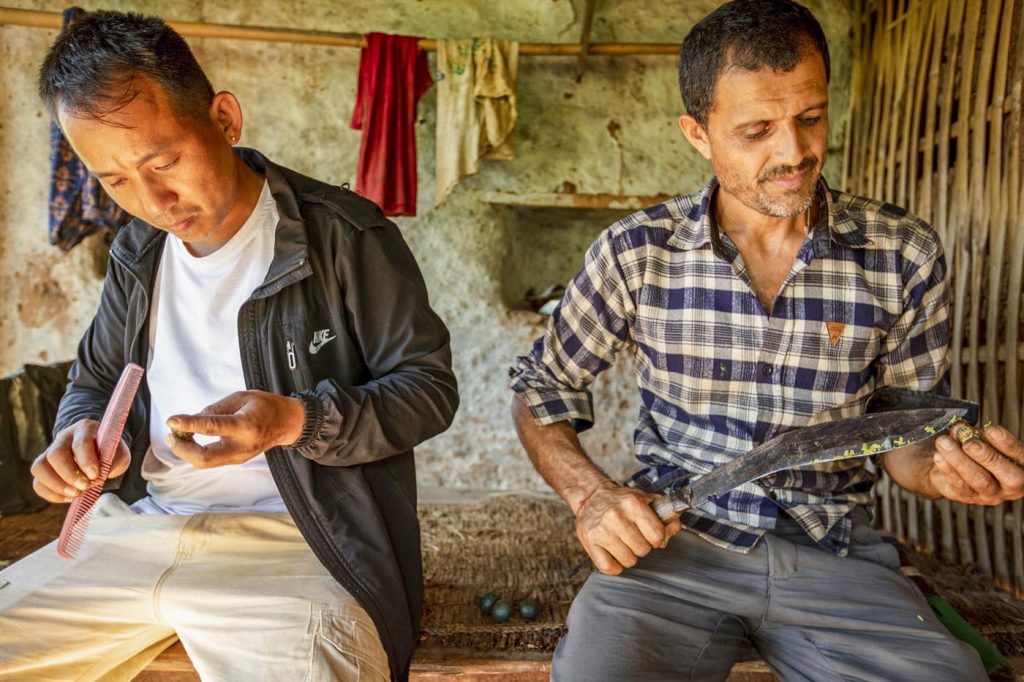



After two days Agam Singh Rai packs a tractor with the yield from his 150 trees—34 heavy sacks, nearly 2,700 pounds of beads. After cleaning, the they will be drilled and crafted into products in his studio in Kathmandu. Not all engage in this value-added work. Some traders simply export packages of the common variety of beads to India. Agam hires laborers to drill and string the beads and then make japa malas (garlands used for reciting mantras) of 108, 54 or 36 beads interspersed with pieces of red or pink velvet. A 108-bead mala may have a “guru” bead added, to help mark the cycle of mantras, such as “Aum Namah Sivaya,” as the beads are turned in the hand. His workshop also produces bags, key chains and backrests for car seats.
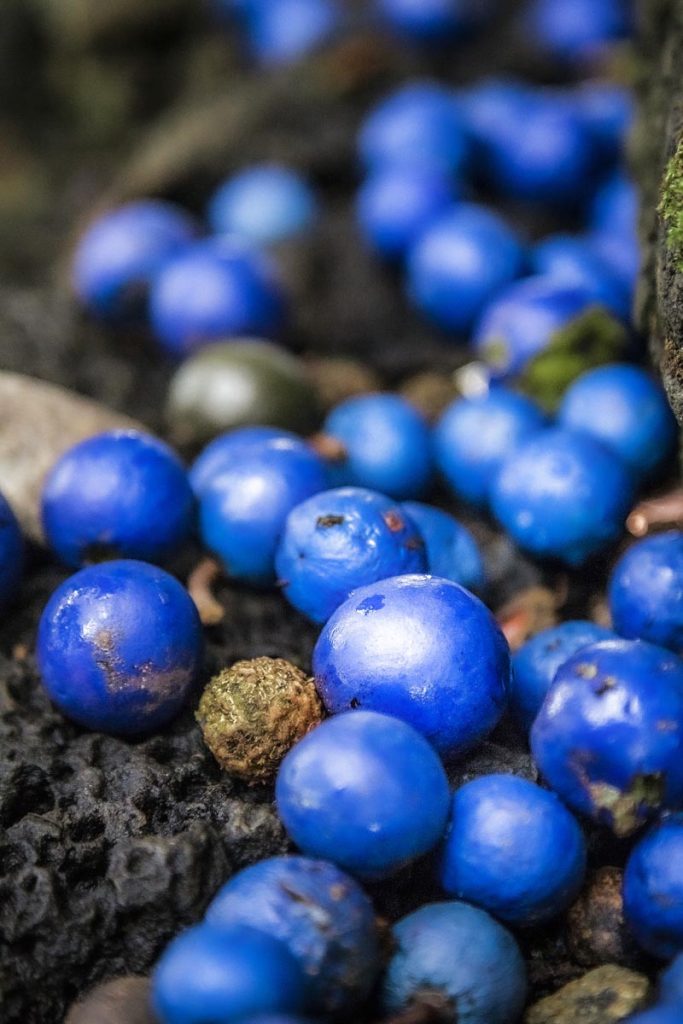

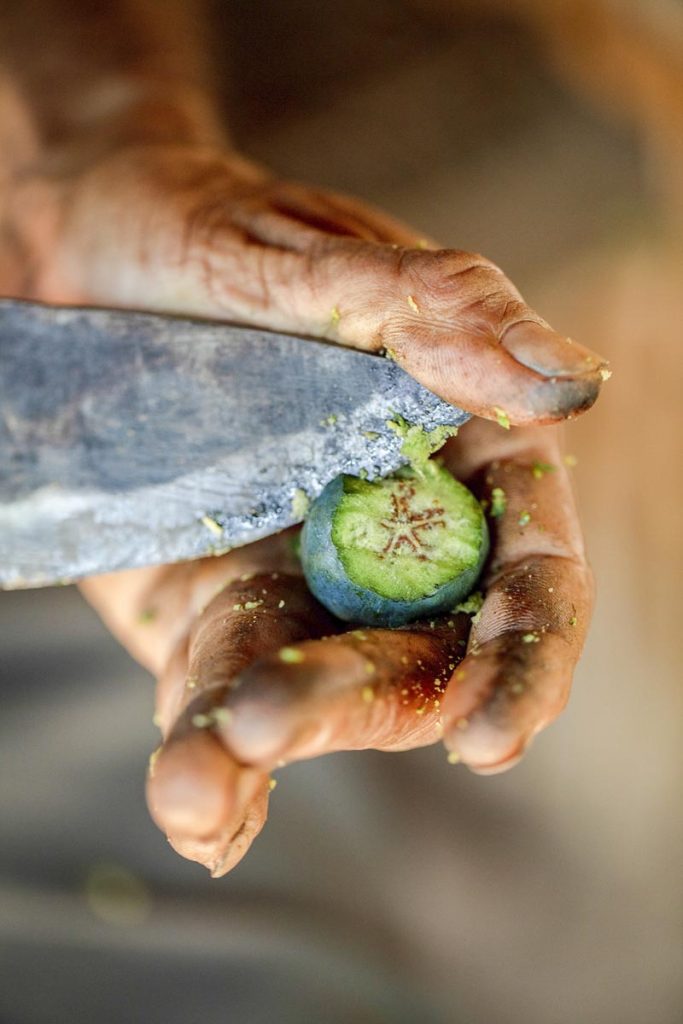

The Sacred Rudraksha Tree
Rudraksha (Elaeocarpus ganitrus, E. grandis, E. serratus (from Sri Lanka) and E. sphaericus) is an evergreen softwood tree, elaeo meaning ‘oil’ and carpus meaning ‘fruit.’ The trees, with their rough-textured, grayish-white bark, can grow to a height of 30-60 feet and bear a handsome crown of oblong, shiny green leaves. Among the green foliage it is common to see a cluster of leaves that are bright red. It’s quite striking. Many of the mature trees are buttressed at the base (see photo above) by strong roots radiating out along the ground. In spring, dense racemes of tiny white flowers with fringed petals appear, and then the tree bears its small, round green fruit which, as they ripen, turn blue or violet by autumn. World War I aviators regarded the wood as the choicest for making airplane propellers, due to its light weight and ability to sustain torque without breaking.
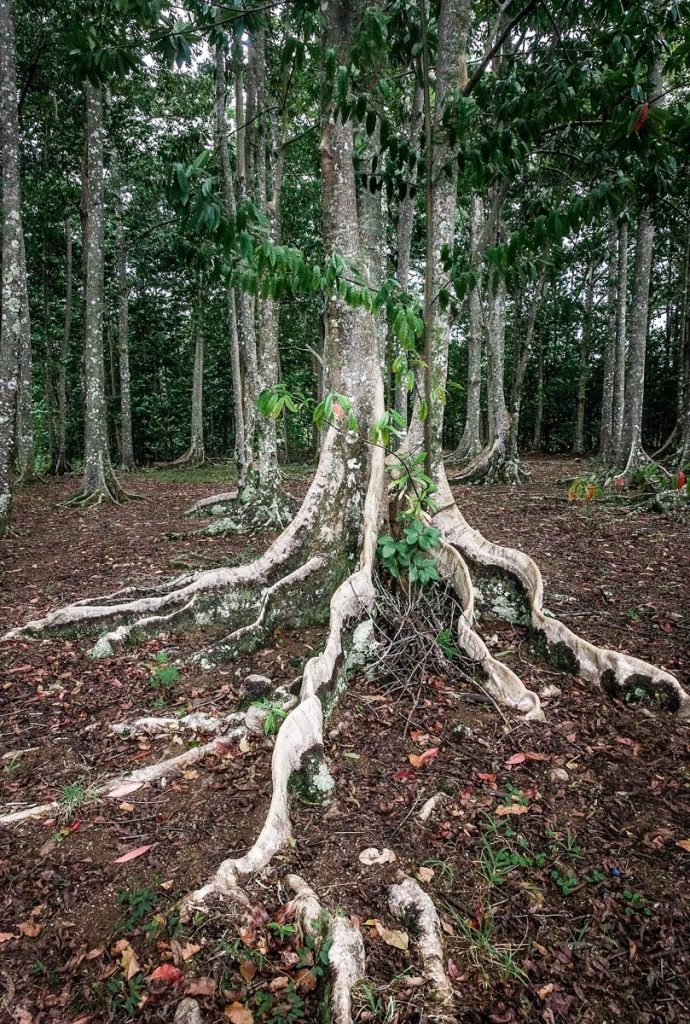

Nepal’s rudraksha forests are expanding as farmers convert their traditional agricultural fields to rudraksha orchards. At the peak of the monsoon season, farmers come from near and far to collect two-year-old saplings that nurseries of the Forestry Sub-Division distribute free of cost. Each year about 4,000 saplings, roughly a foot tall, are carried away to be planted. The young trees will require minimal care and start to fruit from the third year, although beads produced from the fifth year onwards are of better quality. The ultimate quality of the rudraksha may depend largely on the climate, soil and altitude. The trees are happiest at about 1,000 meters but are also known to be highly productive in Australia and Hawaii, where there is a sacred forest planted by monks in 1978 (the same monks who produce this magazine). As an example of variation, the trees in the Arun Valley in Sankawasabha district yield smaller beads than the trees near Bhojpur district, where rudrakshas are larger and take longer to mature.
The Future of the Trade
It’s not just traders, contractors, farmers and producers of final products who benefit from the rudraksha business: hoteliers like Sudarshan Dhakal do, too. He says, “I don’t have an eye for rudrakshas, but nevertheless I am earning from them. My fifteen-room Kanchenjunga Hotel in Tumlingtaar is fully occupied by Chinese buyers for five months. Who would come to this district if its trees did not produce the finest beads in the world? Not just hoteliers but vegetable vendors, motorbike renters, fast-food stalls, harvesters and packers and a lot of others look forward to the harvest season.”
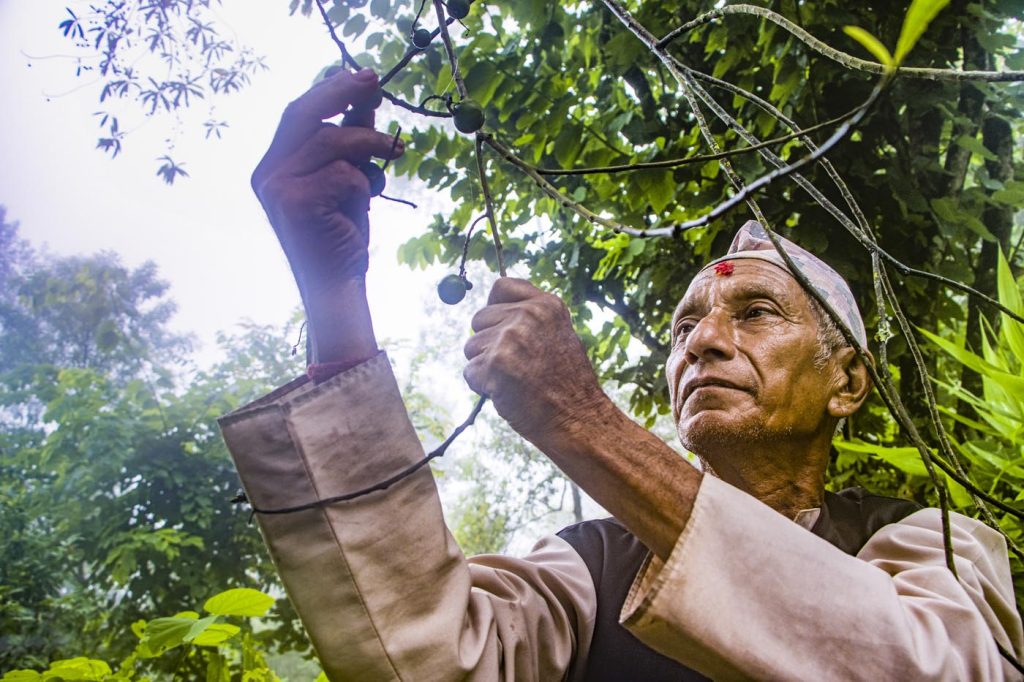

Many farmers who have become traders remember when the beads had little value. Aakash Kumar Shrestha, a farmer in Khandbari, recalls, “Our fathers didn’t understand the value. They might eat the seeds inside or collect good ones and offer malas of rudrakshas to sadhus and saints who passed through the region. Honestly, we don’t know why the rudraksha is so important or why people pay so much money for it. We have around 80-90 trees and earn good money when the Chinese come.”
Durga Bahadur Baral, who like Aakash has been in the business for twenty years, remembers: My grandfather used to tell us how sadhus would come to this region to collect rudraksha. They used to educate us about the importance of wearing different mukhi rudrakshas, thus there was already awareness of the spiritual importance early on. Sixty years ago my father gave them away for free. He take bags of them to pilgrimage sites to give to sadhus or make offerings at temples. This was considered to be a great punyam (good merit). Then gradually people started trading. The whole region is now dependent on this industry, and I hope that with your article, rudraksha will become sought after in America as well.”
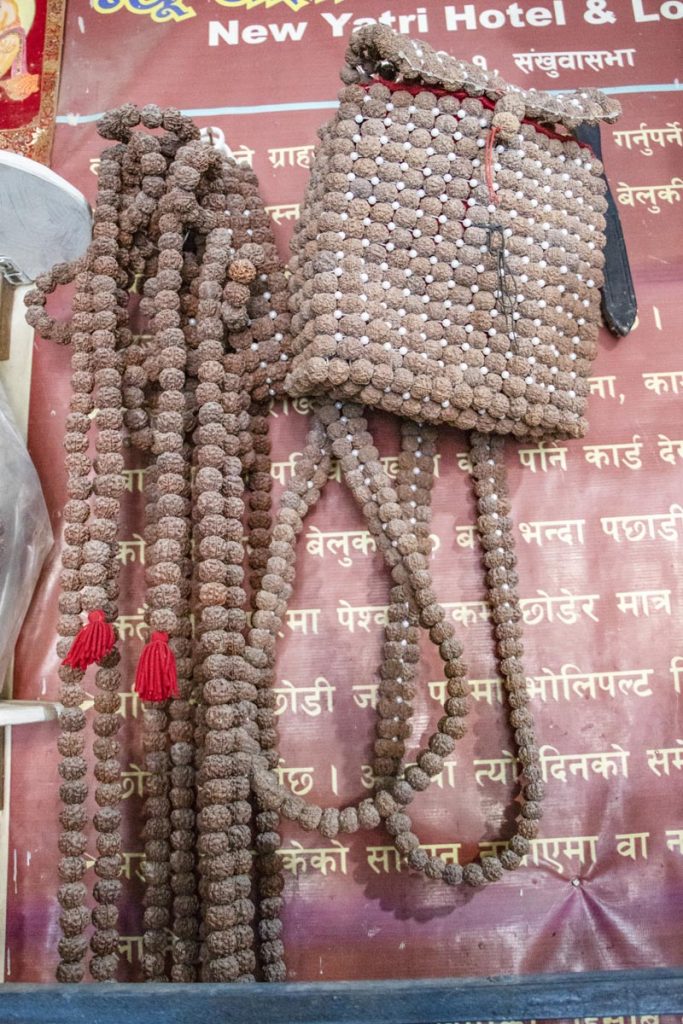

But with the fresh opportunities opened by the growing and selling of the beads, there are pressing concerns about regulation. The beads must be genuine, without extra hand-carved lines or glue, so there are calls for a government certified lab. Currently numerous companies offer lab tests and x-rays, but their legitimacy is questionable.
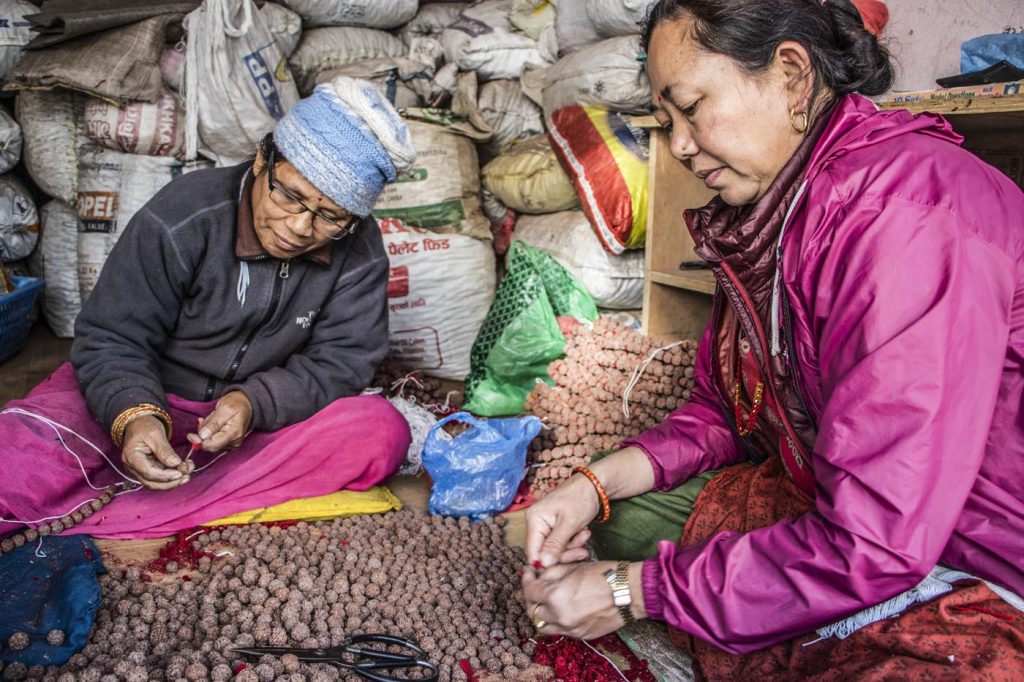

Nor should the growth of trees be aided by chemicals. Bir Bahadur Shrestha of the Nepal rudraksha Traders Association is worried about the recent increase in chemical use. “It has dampened the reputation of Nepalese rudraksha in India and moreover harmed the trees. It may be lack of knowledge in mixing the dosage. We have also begun a campaign to discourage manipulation of the beads. It is ironic that the clamps and chemicals are imported from China, automatically sending back the money that the Chinese have brought into Nepal.”
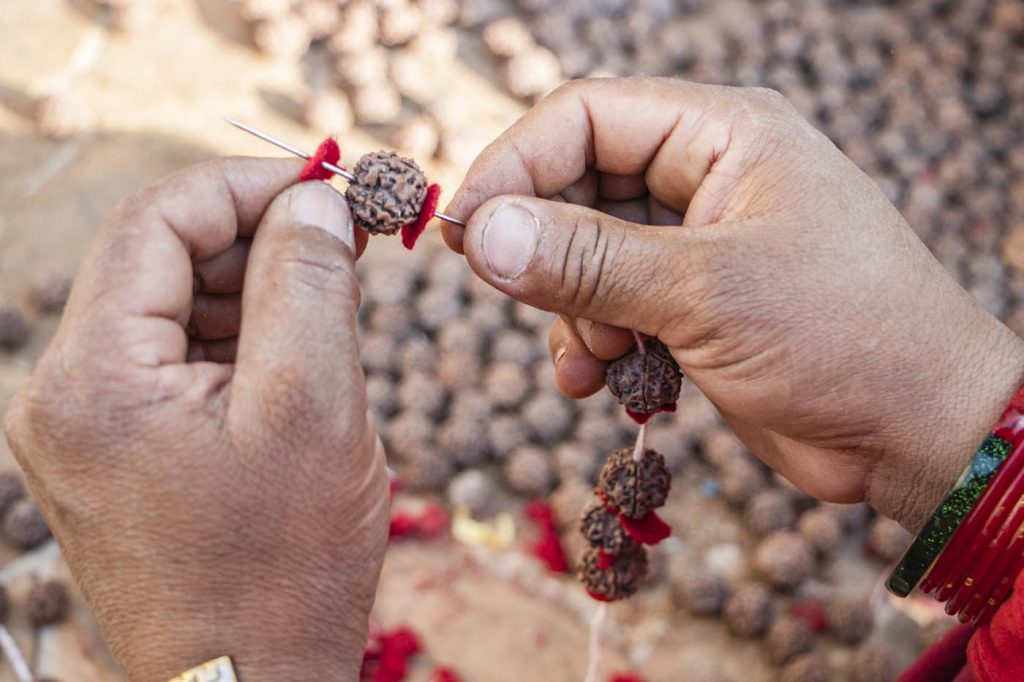

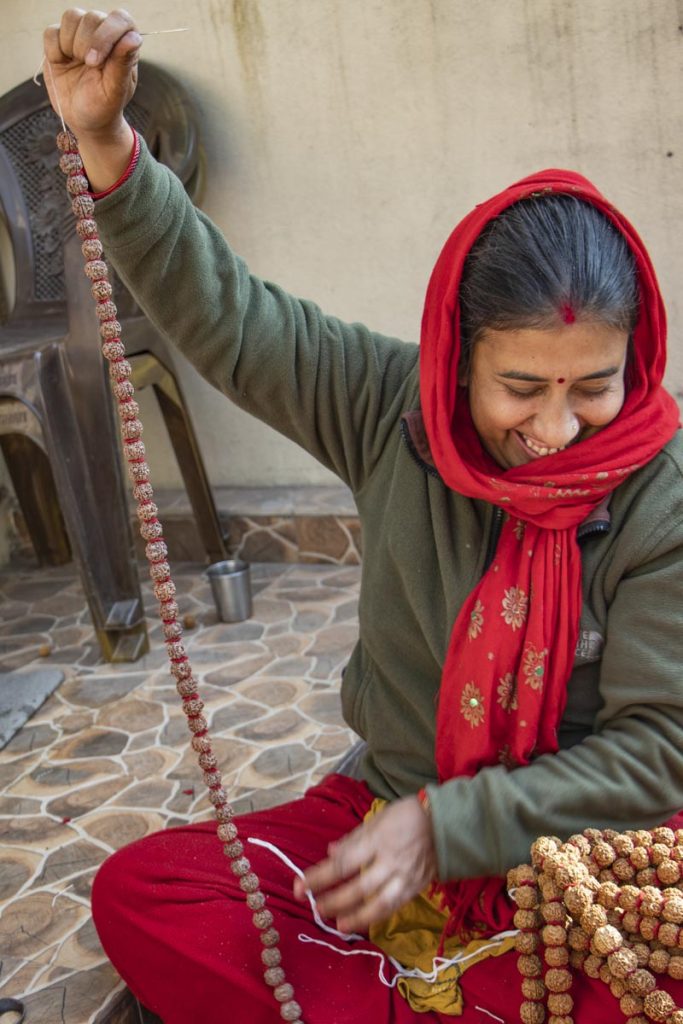

Some farmers and traders wish for a better taxation system. Currently the government of Nepal taxes rudraksha sales by volume rather than according to the actual money earned. Hence a farmer who sells but a few highly priced 21-mukha beads may pay no tax, while a farmer who sells 50 sacks of ordinary ones is charged heftily. Farmers also have difficulty depositing their earnings, since they cannot validate the source, nor can they take bank loans against their valuable beads. If the industry were better regulated, people working all through the value chain would benefit.
For the farmers, this unusual bead clearly offers hope for a better future. Yet there are many unknown factors. Will the Chinese market stabilize and continue to grow? Will the commercial value of beads increase around the world? Will the supply of beads exceed demand, and farmers regret having converted agricultural fields to rudraksha forests?


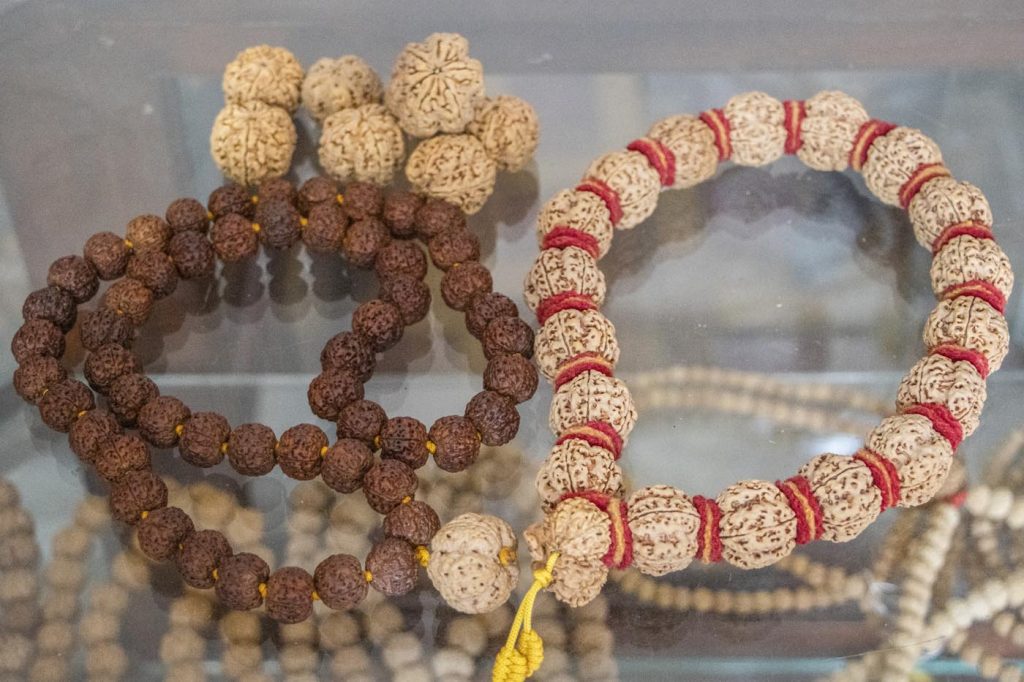

Indian trader Kabir Singh says, “There is a big market for rudraksha in Tamil Nadu. The Nepali traders could tap into that potential. During Mahashivaratri, everybody wants to buy rudraksha. But my sole purpose of bringing these to India is to earn punyam.” His goal is not to make profit but to gift temples, friends and family with the holy beads. “We have people in India who can energize these beads for different spiritual purposes. The beads from Nepal are truly special.”
Nabin Gauli, a hotelier in Sankhuwasabha, gave up the rudraksha-bead business that had nurtured him for years because of his 74-year-old mother, Sushila admonition. A Siva bhakta and follower of Om Shanti, she requested Nabin not to bring home money that had been made by selling the beads that are as holy as Lord Siva himself.
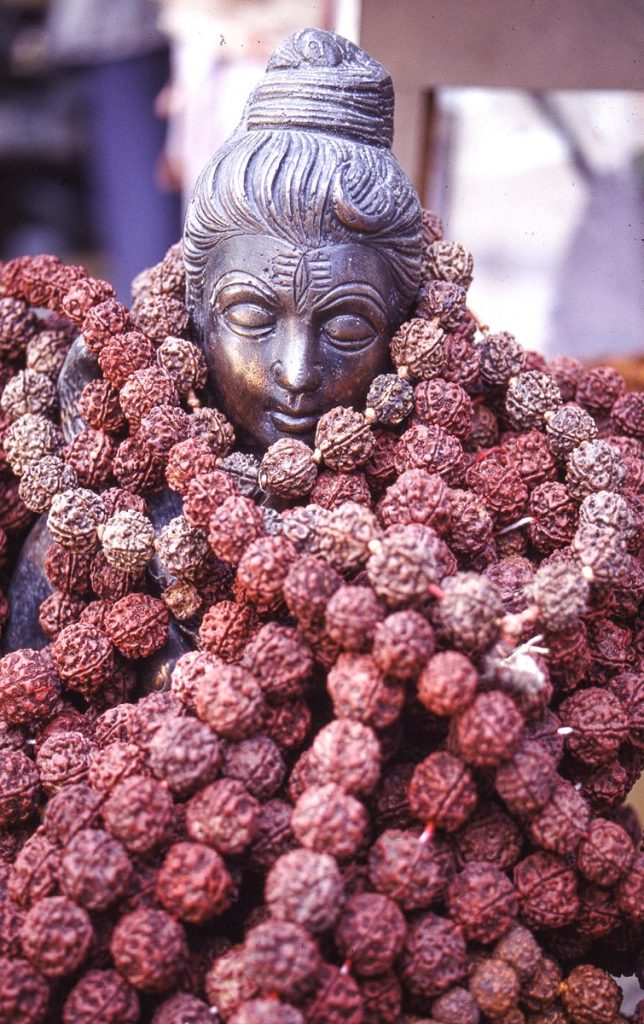

What will remain stable and true is faith in the spiritual power of the rudraksha. The mala that so many of us hold in our hands, counting the beads whose color deepens with time, is a dear companion and reminder of our spiritual quest. May the trees be nurtured then, for their many benefits to mankind, both spiritual and economic.


About the Author
Nikki Thapa is a photographer and photo editor. Her website, askmeaboutnepal.com, is a rich resource on Nepal’s culture and traditions. nikkithapa@gmail.com.


